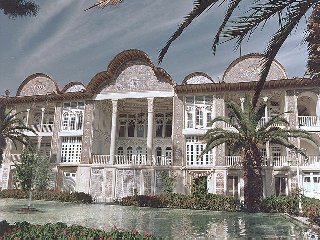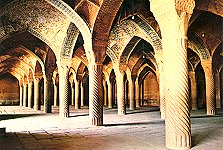|
|
|
|
|
|
|
PersianIran.com |
||||
|
|
|
|
|
|
SHIRAZ
The Capital of Fars providence is Shiraz, one of the most beautiful, historical cities in the world. Farsi the language of Ancient Fars (Pars), has become the official language of Iran, i.e. Persian.The first Capital of Fars, some 2500 years ago, was Pasargad. It was also the capital of Achaemenian King Cyrus the Great. The ceremonial capital of his successor, Darius, and his son Xerxes, was Persepolis. Today, only the ruins of these two capitals remain. Estakhr was another capital of Fars. It was established by the Sassanians and lasted until Shiraz finally assumed the role of the regional capital.
Shiraz is also the birthplace and resting place of the great Persian poets Hafez and Sa'di. There are two remarkable monuments in Shiraz. One is dedicated to Hafez, the master of Persian lyrical poetry. The other one is dedicated to Sa'di, the author of the famous Golestan, and a book of sonnets called the Garden of Roses.
According to Islamic historians, Shiraz came into existence only after the Arab conquest of Iran. The Arab invasion, in fact, contributed to its importance and by the 13th century, Shiraz had grown into one the largest and most popular Islamic cities of the era. Shiraz lies spread out like an immense garden on a green plain at the foot of the Tang Allah-o-Akbar Mountains.
The most interesting buildings in Shiraz are located in the old part of the town. Among them are about a dozen mosques, some with bulb-shaped domes, and others with pear shaped domes and cupolas. These mosques are mostly scattered in among the old houses.
Important places :
| Most of the gardens for which Shiraz was once famous are now long gone, but the town still has a number of parks and gardens, which are particularly pleasant to wander through in the summer. One of the most popular gardens is Bagh-e Eram (Eram garden) in the north-west of the town, which is famous for its cyprus trees. The 19th century Qajar palace lies in the middle of this garden, with its own reflecting pool. |

|

|
The Masjed-e Vakil (the Regent Mosque) has an impressive portal containing faience panels in floral designs with various shades and colors on each side. The northern iwan (verandah) is decorated with shrubs and flowers, mainly rose bushes. The ceiling in Mihrab Chamber (altar) is covered with small cupolas resting on twisted columns. Vakil Bazaar, which is close by, was built by Karim Khan Zand. Here silversmiths and jewelers still apply their trades of exquisite inlay work. Persian carpets and other traditional Persian handicrafts may also be purchased in the Vakil Bazaar. |
| Hafez tomb is the closest to the town centre. Built in 1953 in a garden, the mausoleum is a small open pavilion; inside which is a marble tombstone with several of the poet's verses. One of the nicest tea-houses (chaikhaneh) in Shiraz can be found in the grounds, set around a rectangular pool. You can sit around on cushions sip a cup of tea, or rose water while reflecting on his poetry. Hafez spent most of his life in his native town and died there in 1389. He is considered the undisputed master of the ghazal1, and his poems reflect a richness and a subtlety unequalled even by the other great talent, Saadi. |

|

|
Sa'di's tomb is in the north-east of Shiraz. Set in a pleasant garden, the present tomb was built in 1952 and replaces an earlier much simpler construction. Unlike Hafez, Saadi travelled extensively in Iraq and Syeria, where he was even taken prisoner by the Crusaders. Upon his return to Shiraz, Saadi wrote his most famous works, the Bustan (The Orchard) and the Golestan (The Rose Garden), which are moral tales written either in verse or in a mixture of prose and verse. Saadi is said to have died in 1290 at the grand old age of 101. |